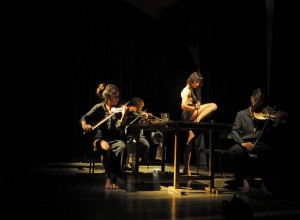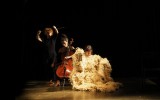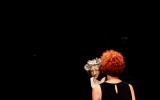Corpo Unico - Quartetto Maurice - Amalia Franco - Giulia Lorusso
Corpo Unico - Sound Opera for animated and inanimate bodies: for string quartet, dancer, puppets and electronics
by Quartetto Maurice - Amalia Franco - Giulia Lorusso
Project supported by Metamorfosi Notturne, ProQuartet, La Terra Galleggiante.
MORE INFO ----> CORPO UNICO DOSSIER - CORPO UNICO DOSSIER FR - TRAILER
First Work presentation, studies on Corpo Unico 1, 2, 3: 7th September 2019 for Immagini dell'Interno.
Streaming version for spazio1984 1th July 2020
press :
CORPO UNICO
The starting point is a certain opaqueness, the crack of a stable referential system in which we use to recognize genres, to distinguish them and to place safe
boundaries.
The aim is to overtake on the “right”, to overcome the concept of multidisciplinarity, in order to put che conditions for a dialogue between genres; confronting,
overlapping them as far as they bled up in a single generating body. An indistinct body, naturally sonorous, who does not discriminate; the child-body who still doesn’t
know or think to be something else from the world. Perhaps a shameful body, without any discernment.
Thinking rationally, we would be swallowed up by the need to define roles, looking at the string quartet, the performer and the electronics as separate entities: we
choose a different way. We conceive ourselves as a sextet, we aim to challenge the traditional concept of ‘what music is’, trying to overcoming it without denying the
music itself. We want to push ourselves beyond the boundaries of performance, dance and theater, emptying out every idea of representation and looking at movement,
choreography, spoken words as a musical act in its essence.
The sound in itself is just a raw material, a fluid which can convey a musical content (created by a musical thinking). Music begins beyond the sound and involves the
action, the scene, the movement, the word. Music is how all those elements blend up together and how they interact. Thinking music means ‘creating relationships’ into
the sound itself on a first level; between sound, dance and theater on a second level, and, eventually between human beings on a final third level.
After all, life itself can be thought and lived as a musical act, and naturally as love too.
And so, where does the music start? Where does the gesture stand and fall? Where does the gesture ends and the word begins?In the same perspective: where does
the musician's body ends and the instrument begins? Where does the dancing body ends and the inanimate body of a puppet begins?
This Corpus Unicum is a loving body, a sound of love, a retch of love, a love too much love, shameful, free from seduction, a love so inconsiderately, violently
melancholy, a monstrous love, a unbearable love.
'(...) love tends to disappear. It is often considered as a historical phenomenon, a cultural illusion. It is studied, analyzed - and, if possible, it is healed. "Bunuel
THE CORE: four musicians, a viola, a dancer, two violins, three hybrid puppets, a cello, words deprived of any meaning which build a further bridge between body and
sound.
We imagine a work in which each involved artist express him/herself according his/her truest nature: as a musician, composer, dancer / performer / puppeteer. We
believe that, on this path we still can smooth the boundaries between music and image: physical proximity and absence of hierarchy among the artists is the starting
point to smooth these boundaries.
We believe in sharing energies more than in switching places.
The technological means involved are, in this regard, only means and never the goal.
The work, specifically intended in its connotation of work, uses the body as a writing surface, (in the same way a violin ‘writes’ the musician) experimenting the possibility
of manipulation and transformation; reveals or detects the epiphenomenial aspect of hybridization between organic and inorganic. It is properly a practice of spoliation,
which aims to make the subject faltering an to short-circuit every referentiality. It is built not through the proposal of an a priori writing, be it choreographical,
dramaturgical, musical, but through the presence of the single body. The work starts putting all those elements at the heart of the matter.




